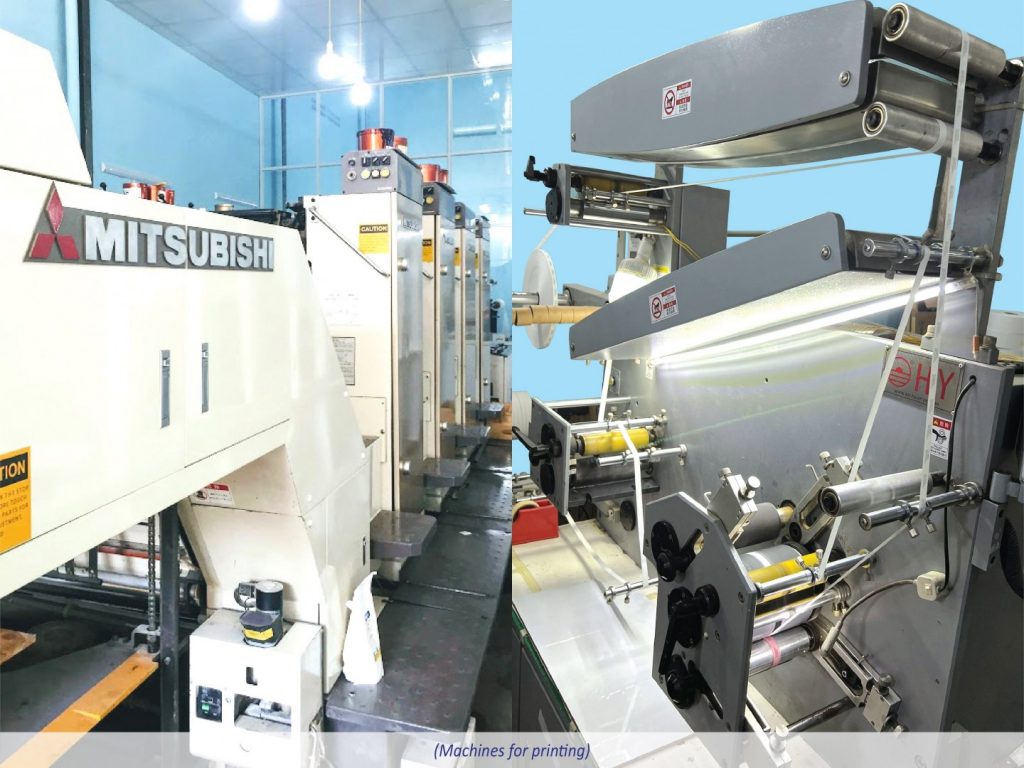News
PRINTING INDUSTRY IN INTEGRATION AND DEVELOPMENT
The domestic consumer market with nearly 100 million people is an attractive opportunity not only for Vietnamese printing enterprises but also for investors in the packaging printing section and ancillary services products.
The development of Vietnam’s printing industry in the current context

According to Dr. Bui Doan Ne – Vice President and General Secretary of the Hanoi Printing Association, Vietnam, the printing industry is a service industry, printing products related to socio-economic sectors. Not only determined of printing books and newspapers, but has become popular and socialized into an industrial of packaging production and tries to meet consumers and promote the brand.
Currently, based on the number of reports of the Department of Publication, Printing and Distribution of Viet Nam, there are more than 2,000 businesses operating in the field of printing, production and packaging printing. The number of business households operating in photocopying and processing printed products has not been counted- about thousands of households with different scales. Total revenue of the printing industry in Vietnam is estimated at over 5 billion USD.
Regarding technology, there are common as: offset, gravure, and Flexo. Offset technology is a statistically high proportion. In addition to using gravure printing technology, Flexo is affirming its competitive position, replacing gravure printing and offset printing in many fields, especially in products friendly with environment. Currently, the technology of direct printing and inkjet printing is being invested by many firms, from advertising products to specialized printing lines for documents and high-end labels. The 3D printing industry has been invested by a number of businesses, globally-connected, and operating on a small scale in Vietnam. Others, printed products are diverse in designs and types, sizes as well as on many materials…
Hanoi and Ho Chi Minh City are two large printing locations where concentrate a lot of domestic printing enterprises. However, in the rank of scale and revenue, many new printing centers are increasing in cities such as Hai Phong, Binh Duong, Hai Duong, Hung Yen, etc….accounting for a high proportion of output and revenue, mainly focusing on big business printing packaging and printing for export.
Analyzing the current characteristics of Vietnam’s printing industry, Dr. Bui Doan Ne said that the number of small and medium-scale enterprises is mainly, includes offset printing enterprises, printing cultural products, books and newspapers. Big enterprises’ revenue is over 200 billion VND, accounting for about 10%. Large-scale enterprises focus on the industrial-zone, printing focuses on packaging and export processing.
In the process of rearranging state-owned printing enterprises, many enterprises have changed industries, diversified products, downsized, and shifted to packaging production and printing. Currently, there are still a number of state-owned printing enterprises operating in the field of publications, newspapers and special industries such as printing money and maps. The field of packaging printing is mainly involved in joint-stock enterprises, joint ventures and limited liability companies and individuals.
Printing enterprises have focused on market-based production, invested in technological advantages and met the traditional market. Limited investment spread, and in-depth investment has brought the brand to the business, even in the field of book printing and cultural products. In general, the field of printing cultural products attracts a large number of small and medium-sized printing enterprises, this field is highly competitive, still maintaining a growth rate of about 10% in output but low profit. Packaging printing has a high growth rate- over 20%. The market for printing packaging and high-quality packaging is attracting domestic and foreign investors. This is a market that requires a high level of investment.
The number of employees in the printing industry is about 50,000 people .Because income is not attractive so the labor in the printing industry fluctuates and often moves to other industries with better conditions and income and also lacking professional training. The training institutions are lacking and do not have enough facilities to train skills to meet the needs of enterprises. Paradoxically, the lack of training facilities still lacks resources, and businesses do not have a strategic policy on labor.
Printed products meet the needs of domestic production, but the competitiveness in quality and cost is still low compared to Thailand and Singapore. Many companies are turning to in-depth investment, process improvement, and quality management systems have affirmed their brands and have stable customers.
Investment in the printing industry is still low and spread, lacking in-depth and proactive investment projects. Small and medium enterprises, outdated technology, the investment is often natured complementary and replaced the existing old line. Large enterprises choose new, synchronous and environmentally-friendly technologies and specialize, not spreading, and effectively.
Impacts and affection on the printing industry in Vietnam
According to Dr. Bui Doan Ne, at the present, the printing industry is affected by many factors such as: the rapid development of information technology, newspapers and magazines (paper) has decreased significantly, especially the trending of advertising via television channels or social networks. The number of printed products decreased, but the product categories and orders were diverse. Reading cultures and different needs still make the number of books and newspapers increase, but the number of copies decreases, runtime required is fast. Enterprises printing in cultural products basically still maintain business and revenue as well.

Second, printed products and packaging require increasingly high-end print quality and a variety of designs. The conversion of printed products, clean and safe packaging has been compulsory and be the initial evaluation condition of the product creation process. Besides, recording variable costs to confirm the quality, time, and security of products is also a requirement for the printing industry to reach. The packaging printing market not only attracts the attention of Vietnamese printing enterprises but also the interest of foreign investors to directly invest in or buy companies. According to the Packaging Association, packaging output will increase by an average of 20% per year (estimated growth in the period of 2015-2020: packaged food increases by 38%, of which processed meat and seafood will increase by 58). %, baby food increased by 76%. This case requires many requirements: not only beautiful and well-preserved models, but also contain instructional information and brand promotion.

Packaging products are various of types and styles, so packaging materials are also rich and diverse. Besides paper, plastic is popular too, many sources of environmentally friendly and safe materials for users are researched and replaced in the packaging industry.
The printer, printing materials and raw materials manufacturing industry has absorbed scientific achievements in time. New-generation printers are simple to operate, products are highly automated, including quality control. With auxiliary control devices, the printing line is gradually closed and the quality is really stable, the loss compensation rate is very low. In addition to the introduction of modern, fast-speed, high-speed, gravure, and offset printing lines, Flexo printing, gravure printing, integrated and synchronous print mode, we witnessed an explosion in direct printing and digital printing.

Notably, the socialization of the printing industry helps to attract resources and qualify for concentrated and long-term investment. Vietnam is a promising market that attracts foreign investment and has a high growth rate. Ensuring domestic-export products and services, including the domestic consumer market with nearly 100 million people, is the clearest manifestation of the attractiveness of investors. Moreover, export processing is an opportunity not only for Vietnamese printing enterprises but also attractive to investors in the field of packaging printing and supporting products.
Solutions to develop Vietnam’s printing industry
According to Dr. Ne, for developing printing industy, it is really necessary to synchronously deploy solutions, which focus on: companies need to develop business strategies and have effective investment plans; specialize and synchronize management solutions for quality, stability and delivery time guarantee; long-term investment, connect traditional customers, expand potential customers, prospects. For small businesses, it had better find a niche market, specialize and expand the links with other enterprises in the printing chain.
Paying attention to the training of human resources, absorbing new technologies to meet the requirements of exploitation and standardization of work. Training, recruiting and having a good policy on using employees, creating a stable labor source are the advantages of the business.
Along with in-depth investment, building and perfecting international quality systems such as ISO 9000, ISO 14000, SA 8000, etc., in order to commit quality and to be qualified for printing for export. These quality certificates which are recognized will help companies promote their brands and expand printing and exporting. Many technical barriers are also a challenge for printing enterprises to perfect their management systems, invest in technology and affirm their competitive position.
Meeting the market, ensuring stable product quality, meeting the demanded trending of design and packaging in the direction of “smart”, safe, secure and timely. The printing industry is always closely linked with the market -which is an auxiliary industry chosen by local manufacturing and wishes for long-term cooperation. If stand by from the beginning, printing companies can develop together with high-tech global brands such as Canon, Samsung, Apple….
The printing industry is one of the leading manufacturing industries in adopting the change in technology. Technology adoption is rapidly shifting from traditional to digital, and with the onset of the fourth industrial revolution (4.0), digital is growing too fast in the printing industry. Printing companies need to strengthen their capabilities with new technologies, invest in synchronous lines, drive innovation, improve customer service, expand markets, and control also operate processes consistently, efficiently.
Surveying, visiting and learning are regular needs of businesses. The support of manufacturers through fairs and exhibitions is an opportunity for businesses to learn to choose technology and equipment and have an effective investment and business strategy. “Hoi In Ha Noi is always responsible for cooperating with professional associations and manufacturers to provide information and organize for printing businesses in group to visit and survey the local and even international” said Dr. Bui Doan Ne.
Compile via dangcongsan.vn – Ha Anh (summary)



 Tiếng Việt
Tiếng Việt

 Zalo
Zalo